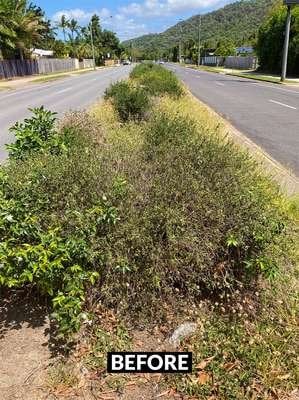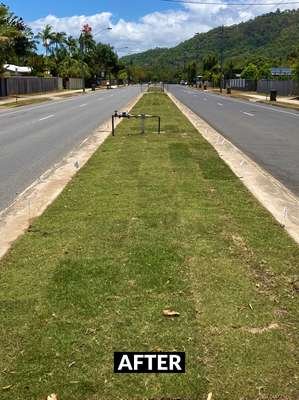Residents Are in Uproar and You Won't Believe the Council's Shameless Response to Their 'Disgraceful' Road Decision!
By
Maan
- Replies 10
In the ever-evolving landscape of local community management, council decisions can ignite passionate reactions. This time, however, the backlash was fierce. The recent overhaul of the median strip along Trinity Beach Road in Cairns, Queensland, has sparked outrage, with residents demanding explanations. Yet, the council’s response, far from soothing tensions, has only fueled the fire.
Grass Over Concrete
The council made changes to the roadside vegetation to improve driver visibility and protect local wallabies. They replaced the restrictive, high vegetation with zoysia grass, which wallabies don’t eat, reducing the risk of them crossing the road and causing accidents.

The grass also offers a softer, cooler alternative to concrete, which had drawn significant community disapproval when used nearby. Trees will be added later to enhance shade and biodiversity without compromising road safety.
Turf Transformation Divides the Area
Some residents are unhappy with the changes because they see the new turf as an 'eyesore' and believe it negatively impacts the area’s aesthetics. They feel the replacement of native shrubs and hedges with grass has reduced biodiversity, creating an environment that’s less habitable for insects and other wildlife.

Other critics argue that the new setup will require more water and ongoing, costly maintenance. Additionally, there’s frustration that alternative options that could have supported more biodiversity were not chosen.
A Response That Defies Expectations
In an unexpected twist, the council's reply to the public's frustration was the kind of flippant remark that would be more at home in a pop song than a government statement: 'Haters gonna hate.' This casual dismissal has only deepened the resentment, with residents feeling their concerns are being brushed aside with an air of indifference.

Why Roads Matter So Much
While these changes can be challenging, they’re often made with the intention of improving infrastructure and enhancing community well-being.
However, it's important to remember that roads are more than just pavement and paint; they are essential connections that support people, commerce, and community. For older residents, in particular, changes to road layouts can go beyond minor inconveniences—they can impact safety, accessibility, and overall quality of life. It's not just about getting from point A to point B; it's worth ensuring that infrastructure meets the needs of those who depend on it.

Share your stories and thoughts on how councils can improve their approach to public engagement, especially during controversial decisions. Your input could help shape a future where community voices are respected and heard.
We know that many of you value your communities and the choices that affect them. Have you been affected by council changes in your area? We’d love to hear from you.
Grass Over Concrete
The council made changes to the roadside vegetation to improve driver visibility and protect local wallabies. They replaced the restrictive, high vegetation with zoysia grass, which wallabies don’t eat, reducing the risk of them crossing the road and causing accidents.

The council’s recent changes to roadside vegetation aim to enhance driver visibility while protecting local wildlife. Image source: Cairns Regional Council on Facebook
The grass also offers a softer, cooler alternative to concrete, which had drawn significant community disapproval when used nearby. Trees will be added later to enhance shade and biodiversity without compromising road safety.
Turf Transformation Divides the Area
Some residents are unhappy with the changes because they see the new turf as an 'eyesore' and believe it negatively impacts the area’s aesthetics. They feel the replacement of native shrubs and hedges with grass has reduced biodiversity, creating an environment that’s less habitable for insects and other wildlife.

Some residents are concerned that the new grass could impact the area's aesthetics and reduce biodiversity, affecting local insects and wildlife. Image souce: Cairns Regional Council on Facebook
Other critics argue that the new setup will require more water and ongoing, costly maintenance. Additionally, there’s frustration that alternative options that could have supported more biodiversity were not chosen.
A Response That Defies Expectations
In an unexpected twist, the council's reply to the public's frustration was the kind of flippant remark that would be more at home in a pop song than a government statement: 'Haters gonna hate.' This casual dismissal has only deepened the resentment, with residents feeling their concerns are being brushed aside with an air of indifference.

Residents' concerns about the new roadside changes were met with an unexpected response from Cairns Deputy Mayor Brett Olds: 'Haters gonna hate.' Image source: Cr Brett Olds Deputy Mayor - Cairns Regional Council on Facebook
Why Roads Matter So Much
While these changes can be challenging, they’re often made with the intention of improving infrastructure and enhancing community well-being.
However, it's important to remember that roads are more than just pavement and paint; they are essential connections that support people, commerce, and community. For older residents, in particular, changes to road layouts can go beyond minor inconveniences—they can impact safety, accessibility, and overall quality of life. It's not just about getting from point A to point B; it's worth ensuring that infrastructure meets the needs of those who depend on it.
Key Takeaways
- Residents are outraged by a recent council decision to replace high roadside vegetation with zoysia grass for better driver visibility and wallaby safety, criticizing it as an 'eyesore' and a step back for local biodiversity.
- The decision sparked concerns about the grass's maintenance costs, water usage, and the exclusion of more biodiversity-friendly options, leading to frustration among community members.
- The council's dismissive response, including the flippant phrase 'Haters gonna hate,' has only intensified public anger and reinforced feelings of being ignored.
- This situation highlights the need for councils to practice transparent communication and meaningful community engagement to foster trust and ensure decisions serve the public effectively.
Share your stories and thoughts on how councils can improve their approach to public engagement, especially during controversial decisions. Your input could help shape a future where community voices are respected and heard.
We know that many of you value your communities and the choices that affect them. Have you been affected by council changes in your area? We’d love to hear from you.







